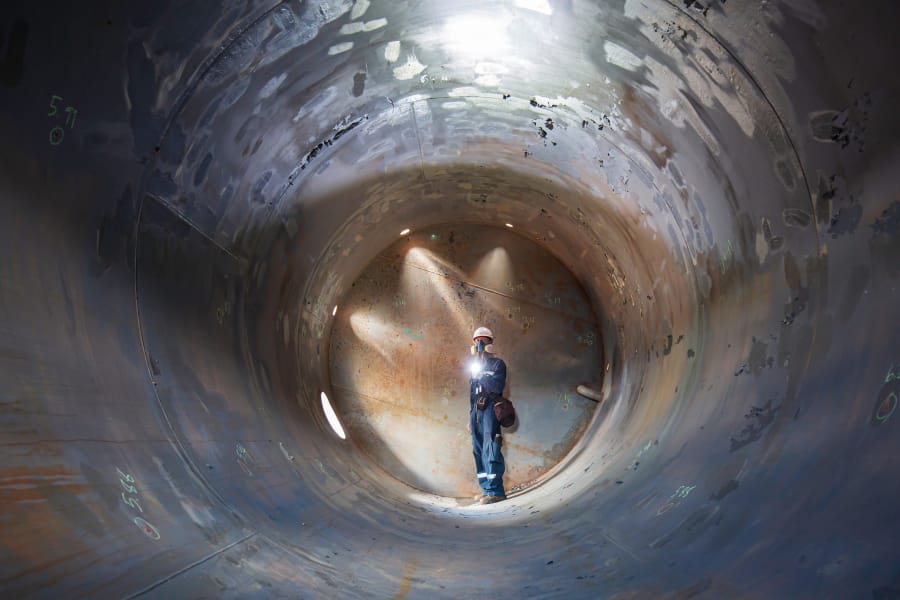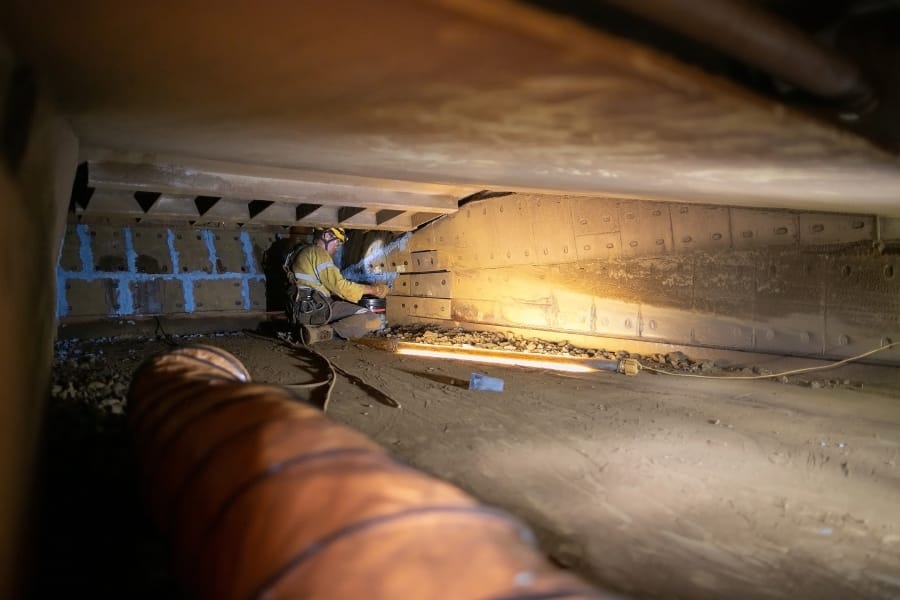Confined spaces are a special area of concern for employers, given the extra hazards they pose for workers. The fact is that each year there are an average of 129 fatalities involving confined spaces, according to recent data, and in many cases the permit space program was not properly put in place. OSHA has specific regulations to protect workers in confined spaces from risks related to entrapment, engulfment, or hazardous atmosphere.
Manufacturers and construction companies need to protect employees and to maintain compliance with OSHA confined space requirements, which often means setting up a permit required confined space program. EMDS can help by preparing documentation that details the safeguards a company has in place to protect employees who have been assigned particularly dangerous job functions.
Defining Confined Spaces
When setting up a confined space program, an important first step is to identify which areas should be covered by the OSHA confined space requirements. Small places like tanks, ducts, open top pits, and crawl spaces can be hazardous for workers who need to enter them for maintenance or another task, so they are usually considered a confined space subject to OSHA regulation. Many of the accidents that occur each year are attributed to the fact that the area was not identified as a confined space.

3 Criteria for an Area to Be Considered a Confined Space
In order to be considered a confined space, the area must meet all three criteria set forth in OSHA’s general industry 1910.146 regulation and construction OSHA 1926.1200 regulation .
- Large enough for a person to completely enter to perform work. For example, if a worker can fit their head and arms in the space to perform work, but not their entire body, the space would not be considered a confined space.
- Has limited or restricted means for entry or exit. If the entrance can become secured from opening from the inside, or if the worker needs to twist, crawl, climb, or exert extra effort to enter or leave the space, that means there is a limited or restricted entry/exit.
- Is not designed for continuous occupancy by employees. A space is not designed for occupancy if it lacks permanent egress/entry, lighting, continuous forced air ventilation, or adequate work space.
Two Types of Confined Spaces
Once an area has been established as a confined space, OSHA further defines two types of confined space: non permit required confined spaces and permit required confined spaces.
Non permit confined space
A non permit confined space (NPRCS) is a space that does not pose any immediate hazards and does not require special precautions for entry. Examples of a non permit required confined space include utility closets, crawl spaces, and basements.
Permit required confined space
A permit required confined space is a space where the hazards to employees are controlled but still present. Examples of a permit required confined space include tanks, vessels, silos, storage bins, hoppers, vaults, and pits.
For these areas, permits must be obtained from OSHA, including (at minimum) a Confined Space Permit as well as any other permits like a Hot Work Permit if welding will be done inside.
4 Characteristics of a Permit Required Confined Space
OSHA’s general industry 1910.146 regulation and construction OSHA 1926.1200 regulation specify four requirements that make a confined space a permit-required confined space (or permit space). Any one of these criteria is enough to qualify the area as a permit required confined space.
(1) Contains or has the potential to contain a hazardous atmosphere;
(2) Contains a material that has the potential for engulfing a person who enters
(3) Has an internal configuration that could allow a person to be trapped or asphyxiated by inwardly converging walls or by a floor that slopes downward and tapers to a smaller cross-section; or
(4) Contains any other recognized serious safety or health hazard.
Wherever a permit space exists, the employer is required to alert workers of the location as well as the dangers associated with the permit space.
OSHA Required Confined Space Program
Employers must have a written permit space program that documents safety procedures to be used in any confined space area, as well as a defined emergency response procedure. The goal is to avoid emergencies or, if a crisis ever does occur, to equip workers and rescuers to safely intervene.
Many confined spaces have unique hazards on top of the regular hazards associated with the space. Ergonomics or stuck-by’s are examples of some non-permit required confined space hazards. Other potential hazards may be falls, the decomposition of materials, noise, heat, lighting, or lockout/tagout.

Equipment
Depending on the nature of the confined space, specialized equipment may be required to protect, aid, or rescue a worker in the space. Required equipment may include signs, radios, helmets, gas monitors, manhole pumps, ventilation systems, and rescue equipment.
PPE required for confined space entry operations
If monitoring and inspection data shows that the permit space has a hazardous atmosphere, workers can only enter a permit space if they are wearing special PPE, such as a self-contained breathing apparatus (SCBA).
Training required to enter confined spaces
As part of your confined space program, workers must be trained on permit space entry procedures and exit procedures, potential hazards, required protective equipment, and rescue and emergency services procedures.
Workers who work in confined spaces should be trained to:
- Recognize hazards
- Alert attendants about presence of hazards and warning signs
- Wear, store and use suitable personal protective equipment
- Conduct self rescue methods in emergency situations
- Communicate with attendants who are outside the confined space
Attendants who are assisting entrants also require training to assess hazardous atmosphere conditions, monitor and coordinate entry operations, and maintain a count of workers in the confined space.
Alternate procedures
In some cases where risks are partially mitigated, permit required confined spaces may be able to follow less stringent alternate procedures. Alternate procedures for permit space entry are allowed only if the confined space meets these requirements:
- The only hazards in the permit space are atmospheric.
- Hazards can be controlled by the use of continuous forced-air ventilation.
- Atmosphere is tested periodically while a worker is in the permit space.
When using alternate procedures, the employer does not need to have a written permit space program, written permit, attendant, or rescue team for the area. However, certification must be completed before anyone can enter the confined space. The certification includes the date, location of the space, and signature of the person providing the certification.
Differences between Confined Space Standards for Manufacturing and for Construction
Confined Spaces in Construction Standard is very similar to the General Industry standard, but in some ways more rigorous. Provisions in the construction standard cover situations where multiple employers are at the worksite, define a “competent person,” require continuous atmospheric monitoring as well as monitoring for engulfment hazards, and allow for permit suspension instead of cancellation.
Many sites may have confined spaces that are sometimes covered under the general industry standard and sometimes under the construction standard. And many jobs performed by contractors are actually maintenance and repair tasks that would be covered by the general industry standard. In those confined spaces, the more stringent Construction standard would cover both situations.
OSHA Documentation Requirements for Confined Spaces
Documentation required to conform to OSHA confined space standards may include:
- Permits
- PPE inspections and cleaning records
- Respirator fit test records
- Permit Required Confined Space signage
- Confined Space signage (for any Non-Permit required confined space)
EMDS Offers OSHA Required Confined Space Program Assistance
EMDS offers confined space consulting for both Construction and Manufacturing to keep your business compliant and certified. Our safety compliance consultant helps document safeguards in place to secure the required OSHA permits, so you can keep your employees safe and maintain compliance with OSHA standards.

